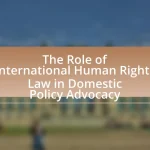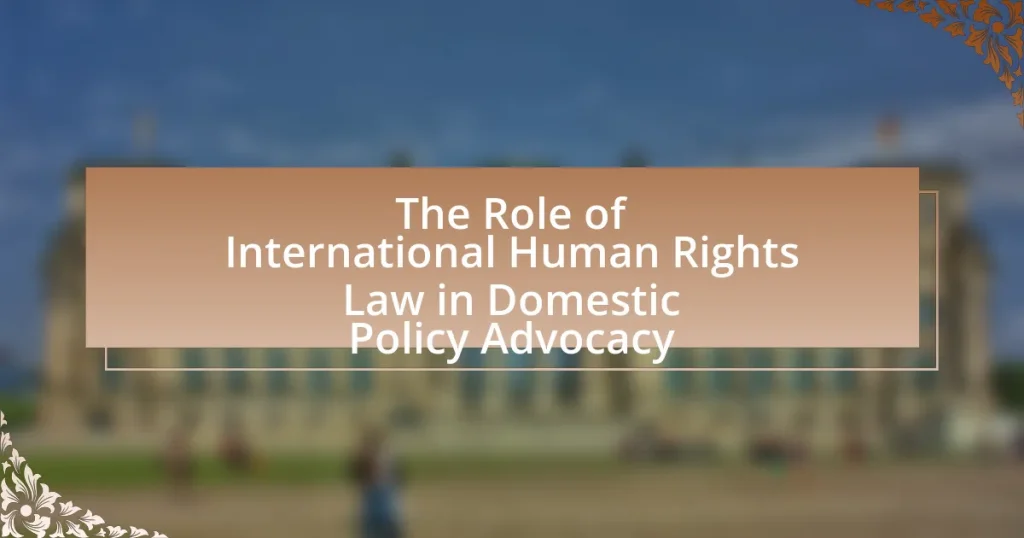International Human Rights Law (IHRL) serves as a critical framework for domestic policy advocacy, establishing accountability standards that governments must follow to protect human rights. The article explores how IHRL influences national legislation, shapes judicial decisions, and impacts marginalized communities by providing legal tools for advocacy. Key principles such as universality, indivisibility, and non-discrimination guide the integration of international norms into domestic policies, while various stakeholders, including NGOs and individuals, engage in advocacy efforts to promote human rights. The article also addresses challenges in implementing IHRL domestically, the role of public opinion, and strategies for effective advocacy, highlighting the importance of collaboration and education in advancing human rights initiatives.
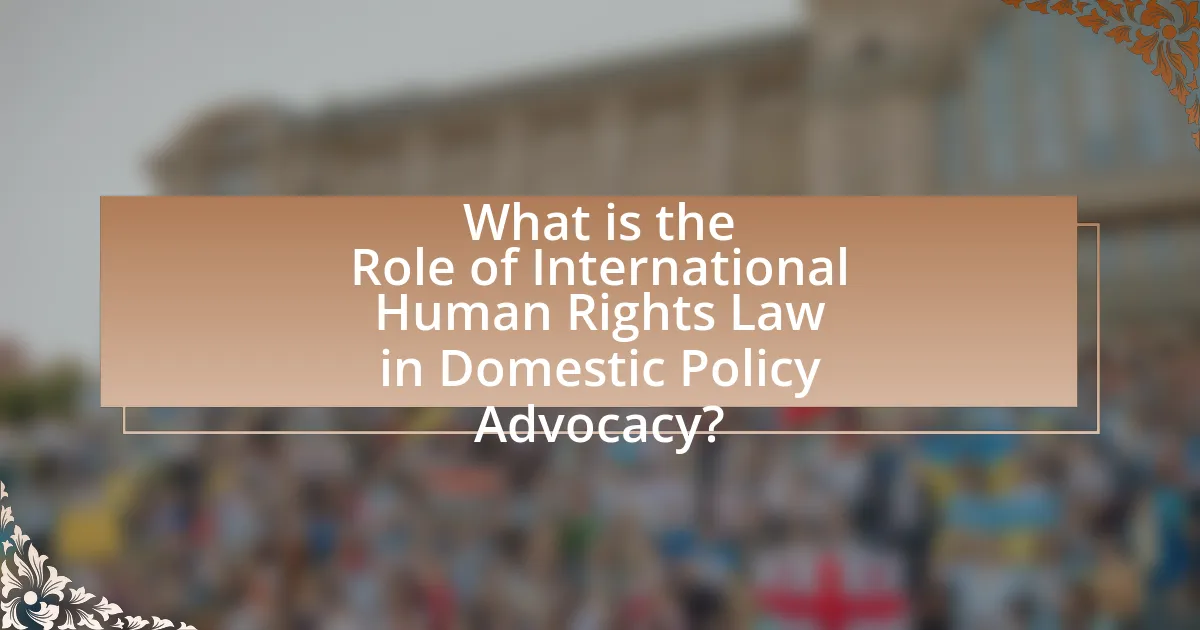
What is the Role of International Human Rights Law in Domestic Policy Advocacy?
International Human Rights Law plays a crucial role in shaping domestic policy advocacy by providing a framework for accountability and standards that governments must adhere to. This legal framework influences national legislation and policy-making processes, ensuring that human rights are prioritized in domestic agendas. For instance, the Universal Declaration of Human Rights and various international treaties obligate states to respect, protect, and fulfill human rights, which advocates can leverage to push for reforms. Evidence of this influence can be seen in countries that have incorporated international human rights norms into their constitutions and laws, leading to improved protections for marginalized groups and enhanced governmental transparency.
How does International Human Rights Law influence domestic legal frameworks?
International Human Rights Law significantly influences domestic legal frameworks by establishing standards that countries are expected to incorporate into their national laws. This influence manifests through the ratification of international treaties, which obligates states to align their domestic legislation with the principles outlined in these agreements. For instance, the International Covenant on Civil and Political Rights requires signatory nations to protect individual rights, prompting many to amend their laws to ensure compliance. Furthermore, domestic courts often reference international human rights norms when adjudicating cases, thereby integrating these standards into national jurisprudence. This process not only enhances the protection of human rights within a country but also fosters accountability and encourages legal reforms that reflect international human rights standards.
What are the key principles of International Human Rights Law?
The key principles of International Human Rights Law include universality, indivisibility, interdependence, and non-discrimination. Universality asserts that human rights apply to all individuals without exception, as established in the Universal Declaration of Human Rights adopted by the United Nations in 1948. Indivisibility emphasizes that all rights, whether civil, political, economic, social, or cultural, are equally important and cannot be prioritized over one another. Interdependence highlights that the fulfillment of one right often depends on the realization of others, illustrating the interconnected nature of human rights. Non-discrimination mandates that all individuals should enjoy their rights without discrimination of any kind, reinforcing equality and justice. These principles form the foundation of international human rights frameworks and guide domestic policy advocacy efforts.
How do these principles translate into domestic policies?
International human rights principles translate into domestic policies by guiding legislation, shaping judicial decisions, and influencing governmental practices to uphold individual rights. For instance, countries often incorporate international treaties, such as the International Covenant on Civil and Political Rights, into their legal frameworks, leading to laws that protect freedom of speech, assembly, and due process. This incorporation is evidenced by the establishment of human rights commissions and the adoption of anti-discrimination laws, which reflect international standards and aim to protect marginalized groups. Additionally, domestic courts frequently reference international human rights norms when adjudicating cases, thereby reinforcing these principles within national legal systems.
Why is International Human Rights Law important for domestic advocacy?
International Human Rights Law is important for domestic advocacy because it provides a framework for protecting individual rights and holding governments accountable. This legal framework empowers advocates to challenge violations of rights within their own countries by referencing international standards, such as those established by the Universal Declaration of Human Rights. For instance, countries that ratify international treaties are obligated to align their domestic laws with these standards, which can lead to legal reforms and enhanced protections for marginalized groups. Additionally, international human rights mechanisms, such as the United Nations Human Rights Council, offer platforms for domestic advocates to raise awareness and seek redress for human rights abuses, thereby strengthening their advocacy efforts.
What impact does it have on marginalized communities?
International human rights law significantly impacts marginalized communities by providing a framework for legal protection and advocacy against discrimination and inequality. This legal framework empowers these communities to claim their rights and seek justice, as evidenced by the increased visibility of issues such as racial discrimination, gender inequality, and LGBTQ+ rights in various countries. For instance, the United Nations Declaration on the Rights of Indigenous Peoples has led to greater recognition of indigenous rights, resulting in policy changes that protect land and cultural heritage. Additionally, the ratification of international treaties, such as the Convention on the Elimination of All Forms of Discrimination Against Women, has prompted domestic legal reforms that enhance women’s rights and access to resources. These examples illustrate how international human rights law serves as a vital tool for marginalized communities to challenge systemic injustices and advocate for equitable treatment.
How does it shape public opinion and political discourse?
International human rights law shapes public opinion and political discourse by establishing norms and standards that influence societal values and government policies. These laws provide a framework for evaluating state behavior, which can mobilize public sentiment and advocacy efforts. For instance, the Universal Declaration of Human Rights has been instrumental in raising awareness about issues such as gender equality and freedom of expression, leading to significant social movements and policy changes in various countries. Research shows that countries adhering to international human rights treaties often experience increased civic engagement and public discourse surrounding human rights issues, as citizens demand accountability and reform from their governments.
What challenges exist in integrating International Human Rights Law into domestic policy?
Integrating International Human Rights Law into domestic policy faces several challenges, including legal compatibility, political resistance, and cultural differences. Legal compatibility issues arise when domestic laws conflict with international standards, making it difficult for governments to implement human rights obligations. Political resistance often stems from a lack of political will or prioritization of national interests over international commitments, as seen in countries that prioritize sovereignty over human rights obligations. Cultural differences can lead to varying interpretations of human rights norms, complicating their acceptance and implementation within diverse societal contexts. These challenges hinder the effective incorporation of international human rights standards into national legislation and practices.
What are the common obstacles faced by advocates?
Advocates commonly face obstacles such as limited resources, lack of public awareness, and resistance from policymakers. Limited resources hinder the ability to conduct effective campaigns and outreach, as many advocacy groups operate on tight budgets. Lack of public awareness about specific issues can impede advocacy efforts, making it difficult to mobilize support or influence public opinion. Additionally, resistance from policymakers often arises due to political interests or competing priorities, which can obstruct the implementation of proposed changes aligned with international human rights law. These challenges are well-documented in studies examining the effectiveness of advocacy strategies in various contexts.
How do cultural and political contexts affect implementation?
Cultural and political contexts significantly affect the implementation of international human rights law in domestic policy advocacy by shaping the values, priorities, and responsiveness of governments and societies. For instance, in countries where cultural norms prioritize collective over individual rights, the adoption of human rights frameworks may face resistance, as seen in various Asian nations where community values often supersede individual liberties. Additionally, political contexts, such as the presence of authoritarian regimes, can hinder the enforcement of human rights laws, as evidenced by the lack of compliance with international standards in countries like North Korea, where the government prioritizes regime stability over human rights. These contexts create barriers or facilitators for the effective integration of international human rights norms into domestic legislation and practices.
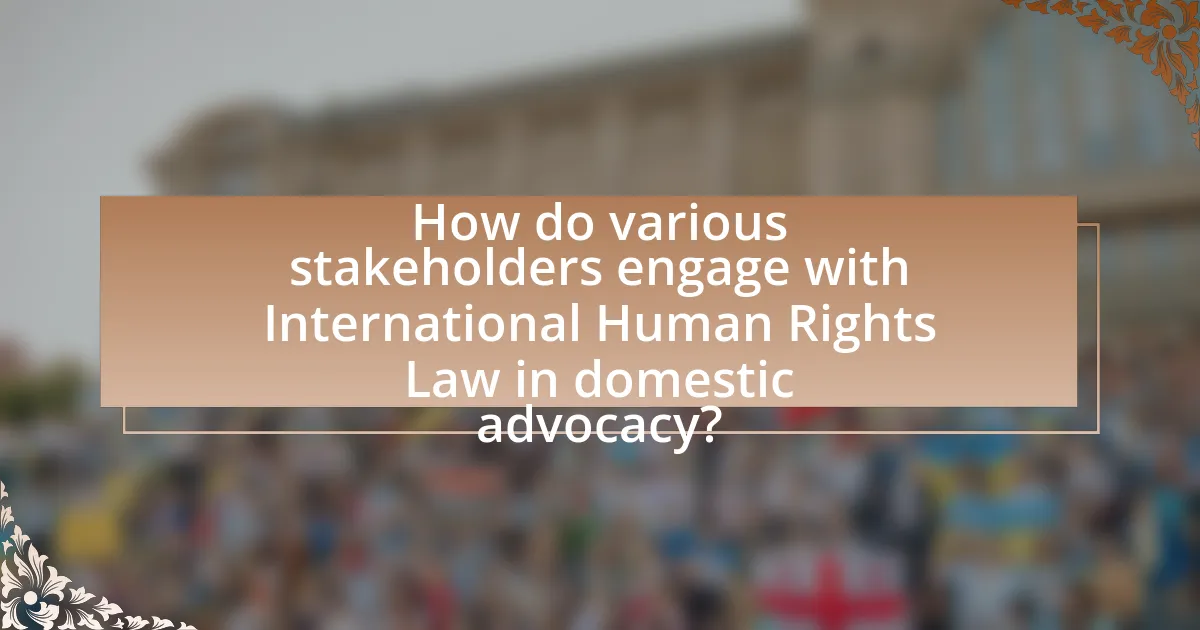
How do various stakeholders engage with International Human Rights Law in domestic advocacy?
Various stakeholders engage with International Human Rights Law in domestic advocacy by utilizing legal frameworks, mobilizing public opinion, and influencing policy-making processes. Non-governmental organizations (NGOs) often leverage international treaties, such as the International Covenant on Civil and Political Rights, to hold governments accountable for human rights violations. For instance, NGOs may submit shadow reports to United Nations treaty bodies, highlighting discrepancies between domestic laws and international obligations. Additionally, legal practitioners use international human rights standards to inform litigation strategies, aiming to secure justice for victims of rights abuses. Furthermore, grassroots movements raise awareness and advocate for policy changes by framing local issues within the context of international human rights norms, thereby fostering a culture of accountability and respect for human rights at the national level. This multi-faceted engagement underscores the interconnectedness of international law and domestic advocacy efforts.
What roles do NGOs play in promoting human rights at the domestic level?
NGOs play a crucial role in promoting human rights at the domestic level by advocating for policy changes, raising awareness, and providing legal assistance. These organizations often engage in lobbying efforts to influence legislation that aligns with international human rights standards, thereby ensuring that domestic laws reflect these principles. For instance, NGOs like Human Rights Watch and Amnesty International conduct research and publish reports that highlight human rights abuses, which can lead to public pressure and governmental accountability. Additionally, they offer legal support to victims of human rights violations, helping individuals navigate the legal system to seek justice. This multifaceted approach not only empowers marginalized communities but also fosters a culture of human rights within the society.
How do NGOs collaborate with international bodies?
NGOs collaborate with international bodies by engaging in partnerships, sharing information, and participating in advocacy efforts. These collaborations often involve NGOs providing expertise and grassroots perspectives to inform international policies, while international bodies offer platforms for NGOs to amplify their voices and influence decision-making. For instance, NGOs frequently submit reports and recommendations to the United Nations Human Rights Council, which helps shape international human rights standards and domestic policies. This synergy enhances the effectiveness of both NGOs and international bodies in promoting human rights and influencing legislative changes at the national level.
What strategies do NGOs use to influence policy change?
NGOs use various strategies to influence policy change, including advocacy, lobbying, public campaigns, and coalition-building. Advocacy involves raising awareness about specific issues and mobilizing public support, which can pressure policymakers to act. Lobbying directly engages with legislators and government officials to persuade them to adopt specific policies or legislation. Public campaigns utilize media and grassroots mobilization to shape public opinion and create a sense of urgency around issues, thereby influencing policymakers. Coalition-building allows NGOs to unite with other organizations to amplify their voice and resources, increasing their impact on policy discussions. These strategies are supported by evidence showing that coordinated efforts among NGOs can lead to significant legislative changes, such as the successful campaign for the Convention on the Rights of Persons with Disabilities, which was influenced by a coalition of NGOs advocating for disability rights.
How do governments respond to International Human Rights Law in their policies?
Governments respond to International Human Rights Law by integrating its principles into domestic legislation and policy frameworks. For instance, many countries ratify international treaties, such as the International Covenant on Civil and Political Rights, which obligates them to uphold specific human rights standards. This integration often leads to the establishment of national human rights institutions and the incorporation of human rights considerations into various sectors, including education, health, and law enforcement. Additionally, governments may face pressure from civil society organizations and international bodies to comply with these laws, which can result in reforms aimed at improving human rights protections.
What are the mechanisms for accountability in domestic law?
Mechanisms for accountability in domestic law include judicial review, legislative oversight, and administrative accountability. Judicial review allows courts to assess the legality of actions taken by public authorities, ensuring compliance with constitutional and statutory provisions. Legislative oversight involves the ability of legislative bodies to monitor and evaluate the actions of the executive branch, often through hearings and investigations. Administrative accountability refers to the processes by which public officials are held responsible for their actions, including mechanisms such as audits, performance evaluations, and disciplinary procedures. These mechanisms collectively ensure that government actions are transparent, lawful, and subject to scrutiny, thereby upholding the rule of law and protecting individual rights.
How do governments balance national interests with international obligations?
Governments balance national interests with international obligations by prioritizing domestic policies that align with global standards while ensuring national security and economic stability. For instance, countries often engage in negotiations to create treaties that reflect both their commitments to international human rights laws and their unique national contexts. A concrete example is the implementation of the Universal Declaration of Human Rights, which many nations incorporate into their legal frameworks, thereby fulfilling international obligations while addressing local needs. Additionally, governments may utilize diplomatic channels to advocate for their interests, ensuring that international agreements do not compromise their sovereignty or economic interests. This dual approach allows for a pragmatic alignment of national priorities with the expectations set by the international community.
What role do individuals play in advocating for human rights?
Individuals play a crucial role in advocating for human rights by raising awareness, mobilizing communities, and influencing policy changes. Through grassroots activism, individuals can highlight human rights violations, educate others, and create a collective voice that pressures governments and institutions to uphold human rights standards. For instance, the global movement for racial equality, exemplified by the Black Lives Matter initiative, has demonstrated how individual actions can lead to significant policy discussions and reforms. Additionally, individuals often participate in campaigns, sign petitions, and engage in social media advocacy, which can amplify their impact and reach a wider audience, thereby reinforcing the importance of human rights in domestic and international contexts.
How can citizens effectively engage in advocacy efforts?
Citizens can effectively engage in advocacy efforts by educating themselves on relevant issues, mobilizing community support, and utilizing various platforms to amplify their voices. Education enables citizens to understand the complexities of human rights laws and their implications for domestic policy, which is crucial for informed advocacy. Mobilizing community support fosters a collective effort, increasing the impact of advocacy initiatives. Utilizing platforms such as social media, public forums, and petitions allows citizens to reach a broader audience and influence policymakers. For instance, the 2017 Women’s March demonstrated how grassroots mobilization can effectively advocate for policy changes, highlighting the power of collective action in influencing public discourse and legislative agendas.
What tools are available for individuals to promote human rights?
Individuals can promote human rights through various tools, including advocacy campaigns, social media platforms, educational resources, and legal frameworks. Advocacy campaigns enable individuals to raise awareness and mobilize support for human rights issues, while social media platforms facilitate the dissemination of information and engagement with a broader audience. Educational resources, such as workshops and seminars, empower individuals with knowledge about human rights laws and principles. Legal frameworks, including international treaties like the Universal Declaration of Human Rights, provide a basis for individuals to challenge violations and seek justice. These tools collectively enhance the capacity of individuals to effect change and uphold human rights standards.
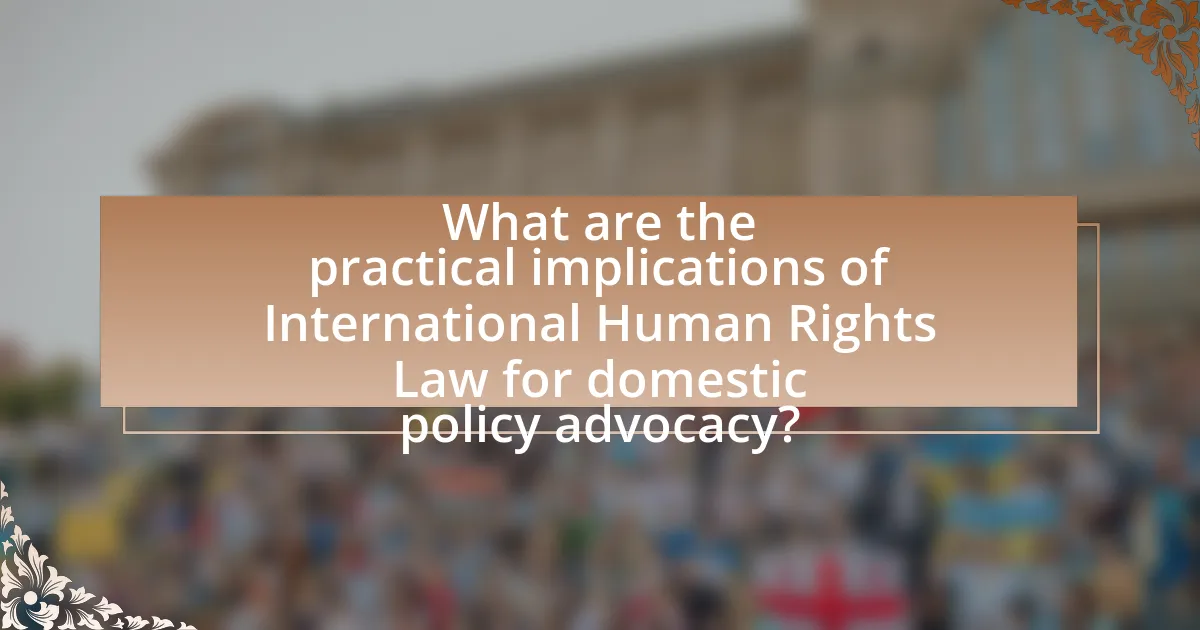
What are the practical implications of International Human Rights Law for domestic policy advocacy?
International Human Rights Law (IHRL) significantly influences domestic policy advocacy by providing a framework for accountability and standards for human rights protection. This legal framework empowers advocates to challenge domestic laws and practices that violate international human rights standards, thereby promoting reforms that align with global norms. For instance, the Universal Declaration of Human Rights and various treaties, such as the International Covenant on Civil and Political Rights, serve as benchmarks for evaluating domestic policies. These instruments enable advocates to leverage international scrutiny and pressure governments to comply with their human rights obligations, as seen in cases where civil society organizations have successfully used IHRL to push for legislative changes in areas like gender equality and freedom of expression.
How can advocates effectively utilize International Human Rights Law in their campaigns?
Advocates can effectively utilize International Human Rights Law in their campaigns by aligning their objectives with established human rights treaties and conventions, such as the Universal Declaration of Human Rights and the International Covenant on Civil and Political Rights. This alignment provides a legal framework that strengthens their arguments and enhances credibility. For instance, referencing specific articles from these documents can help advocates highlight violations and demand accountability from governments. Additionally, utilizing case studies and reports from organizations like Amnesty International or Human Rights Watch can provide concrete evidence of human rights abuses, thereby reinforcing the urgency of their campaigns. By strategically framing their messages within the context of international law, advocates can mobilize public support and influence policymakers to adopt reforms that uphold human rights standards.
What best practices should advocates follow when referencing international law?
Advocates should ensure accuracy and relevance when referencing international law by using credible sources and current legal frameworks. This includes citing specific treaties, conventions, and case law that directly pertain to the issue at hand, such as the Universal Declaration of Human Rights or the International Covenant on Civil and Political Rights. Additionally, advocates should contextualize international law within the domestic legal framework to demonstrate its applicability and importance. For instance, referencing how international obligations influence national legislation can strengthen arguments. Furthermore, advocates should stay updated on recent developments in international law, as this field is dynamic and evolving, ensuring that their references reflect the most current legal standards and interpretations.
How can advocates measure the impact of their efforts?
Advocates can measure the impact of their efforts through quantitative and qualitative assessments, including tracking changes in policy, public awareness, and community engagement. For instance, they can analyze legislative outcomes, such as the passage of laws influenced by advocacy campaigns, or conduct surveys to gauge shifts in public opinion regarding human rights issues. Additionally, case studies can provide in-depth insights into specific advocacy initiatives, illustrating their effectiveness in promoting human rights. Research indicates that organizations employing these methods often report a clearer understanding of their influence, as evidenced by a study from the Center for American Progress, which found that 70% of advocacy groups that utilized data-driven approaches could demonstrate measurable outcomes in their campaigns.
What resources are available for understanding and applying International Human Rights Law?
Resources available for understanding and applying International Human Rights Law include academic textbooks, online courses, legal databases, and international organizations’ publications. Academic textbooks such as “International Human Rights Law” by Olivier De Schutter provide foundational knowledge and case studies. Online platforms like Coursera and edX offer courses from universities that cover various aspects of human rights law. Legal databases such as Westlaw and LexisNexis provide access to case law, treaties, and legal commentary. Additionally, publications from organizations like the United Nations and Amnesty International offer insights into current human rights issues and legal frameworks. These resources collectively support the comprehension and application of International Human Rights Law in domestic policy advocacy.
Where can advocates find training and educational materials?
Advocates can find training and educational materials through various organizations and platforms dedicated to human rights education. Notable sources include the United Nations Human Rights Office, which offers resources and training modules on international human rights law, and the International Federation for Human Rights, which provides educational materials and workshops. Additionally, online platforms such as Coursera and edX host courses related to human rights advocacy, often developed by reputable universities and institutions. These resources are validated by their widespread use in training programs for advocates globally, ensuring access to credible and comprehensive educational content.
What networks exist for collaboration among human rights advocates?
Numerous networks exist for collaboration among human rights advocates, including the International Federation for Human Rights (FIDH), Human Rights Watch (HRW), and Amnesty International. These organizations facilitate cooperation through shared resources, joint campaigns, and advocacy initiatives. For instance, FIDH connects over 190 organizations globally, promoting human rights through strategic partnerships and collective actions. Similarly, HRW and Amnesty International engage in collaborative efforts to address human rights violations, providing platforms for advocates to share information and strategies. These networks enhance the effectiveness of human rights advocacy by fostering solidarity and amplifying voices on critical issues.
What are the key takeaways for successful domestic policy advocacy using International Human Rights Law?
Successful domestic policy advocacy using International Human Rights Law requires a clear understanding of legal frameworks, strategic coalition-building, and effective communication. Advocates must familiarize themselves with relevant international treaties, such as the International Covenant on Civil and Political Rights, to leverage legal standards in domestic contexts. Building coalitions with diverse stakeholders, including civil society organizations and affected communities, enhances credibility and amplifies voices. Effective communication involves translating complex legal language into accessible terms, ensuring that the advocacy resonates with policymakers and the public. These strategies are supported by successful case studies, such as the use of human rights frameworks in advancing LGBTQ+ rights in various countries, demonstrating the tangible impact of integrating international law into domestic advocacy efforts.


